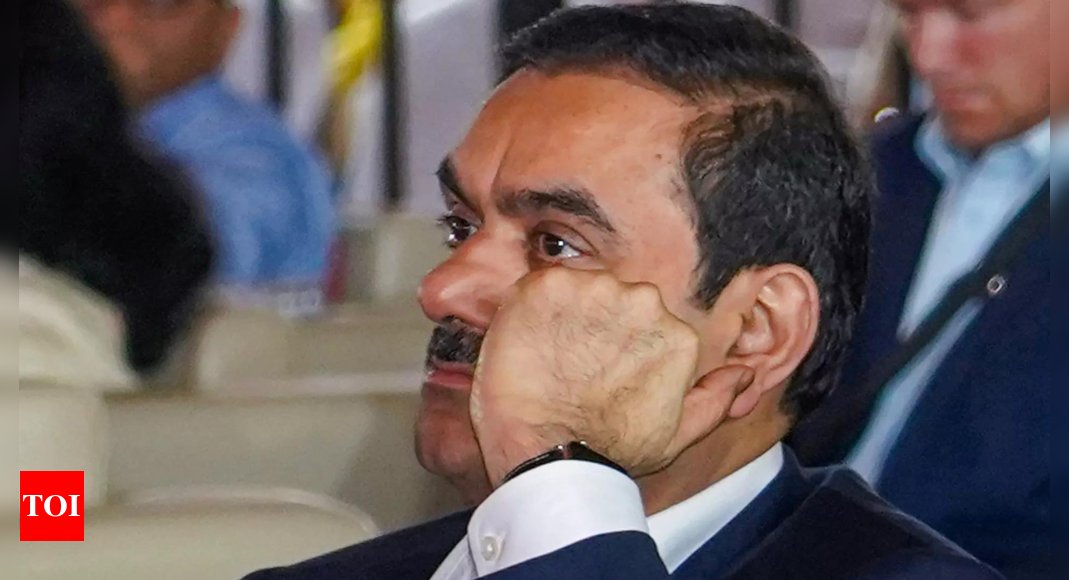
NEW DELHI: The Economic Survey 2023-24 suggests that the increase in retail investors participation in Futures & Options (F&O) trading may be likely driven by the inherent human inclination towards “gambling instincts“.
The survey submitted to the Parliament on Monday, warned that a severe downturn in the stock market might deter young investors from participating.The survey expressed apprehension regarding the increasing popularity of derivative trading and that the speculative activities are inappropriate for a nation that is still developing.
According to the survey, “Derivatives trading holds the potential for outsized gains. Thus, it caters to humans’ gambling instincts and can augment income if profitable. These considerations are likely driving active retail participation in derivatives trading.”
The Securities and Exchange Board of India (Sebi) chairperson, Madhabi Puri Buch, recently issued a warning to investors regarding substantial investments in the Futures and Options (F&O) market.
Before this similar concerns were expressed by finance minister Nirmala Sitharaman and chief economic adviser V Anantha Nageswaran, who highlighted the increasing risks associated with F&O trading for retail investors.
“Market practices that take their cues from the thinly disguised leveraged bets masquerading as financial innovations in the developed world have no place in a developing country with a low per-capita income,” the survey said.
The benchmark equity indexes have experienced a remarkable surge of over 200% since their COVID-19 lows in March 2020, primarily driven by an influx of retail traders in the derivatives market. The share of derivatives trading volumes attributed to retail traders has skyrocketed from 2% in 2018 to 41% this year, propelling India’s monthly notional value of derivatives traded to a global high of 9,504 trillion rupees ($113.60 trillion) in May, according to data as reported by Reuters.
The report warns that retail investors could face substantial losses, as derivatives traders generally lose money on a global scale. Such a decline may leave investors feeling “cheated” and disappointed with their investment outcomes.
“A significant stock correction could see losses that are more considerable for retail investors participating in capital markets through derivatives. Investors’ behavioural response would be to feel ‘cheated’ by unseen more considerable forces. They may not return to capital markets for a long time. That is a loss to them and the economy,” the survey noted.
The popularity of Futures and Options (F&O) trading is on the rise, with market analysts attributing this growth to the potential for financial gains and the increasing trading volumes in the segment.
The segment’s rapid expansion is clearly demonstrated by its impressive growth figures and the “monthly turnover in the F&O segment reaching Rs 8,740 trillion in March 2024, compared to Rs 217 lakh crore in March 2019.”
According to PTI, In comparison, the equity cash segment recorded an average daily turnover of Rs 1 lakh crore, while the F&O segment experienced a significantly higher average daily turnover of approximately Rs 330 lakh crore.
F&O trading revolves around contracts that derive their value from an underlying asset, such as stocks or commodities. Futures contracts obligate the buyer and seller to transact at a predetermined future date and price, while options give the holder the right, but not the obligation, to buy or sell the asset at a set price within a specific period.
These financial derivatives used for risk management, speculating on price fluctuations, and exploiting price discrepancies. These instruments, however, carry substantial risks such as leverage and market volatility, potentially resulting in significant financial losses.
In the stock market, F&O trading has become predominantly a speculative tool for quick gains. The reality, however, is that the majority of retail investors are incurring losses.
According to a Securities and Exchange Board of India (Sebi) study: “89 per cent of individual traders in the equity F&O segment suffered losses, with average losses of Rs 1.1 lakh in FY22.”
The study also highlighted a significant surge in F&O segment participation during the pandemic, with the number of unique individual traders growing by more than 500 percent, from 7.1 lakh in FY19 to 45.24 lakh in FY21.
Sebi chief previously mentioned that the capital markets regulator is “compelled” to caution against speculative trades in the F&O segment, because it has become a “macro issue”, affecting the broader economy now.
Household financial savings are being diverted into speculative trades, contrary to the expectation of being utilized for capital formation. Moreover, young individuals are incurring substantial losses in such trades.
In an effort to address this issue, the Sebi board recently approved more stringent criteria for the inclusion of individual stocks in the derivatives segment. This proposal aims to eliminate stocks with persistently low turnover from the F&O segment of the exchanges.
Last month, the Sebi board approved stricter norms for the entry of individual stocks in the derivatives segment. The proposal is aimed at weeding out stocks with consistently low turnover from the F&O segment of the bourses.
The survey also raises concerns about the rise in the market capitalisation of listed Indian companies. As of July 22, the market capitalisation of companies listed on the NSE, India’s largest exchange, stood at $5.29 trillion, up from $3.59 trillion a year earlier.
In March, the market capitalisation-to-GDP ratio had increased to 124%, surpassing other emerging market economies such as China and Brazil, from 77% five years prior. The survey states, “It is essential to strike a note of caution. If equity market claims on the real economy are excessively high, it is a harbinger of market instability rather than market resilience.”
(With inputs from agencies)
The survey submitted to the Parliament on Monday, warned that a severe downturn in the stock market might deter young investors from participating.The survey expressed apprehension regarding the increasing popularity of derivative trading and that the speculative activities are inappropriate for a nation that is still developing.
According to the survey, “Derivatives trading holds the potential for outsized gains. Thus, it caters to humans’ gambling instincts and can augment income if profitable. These considerations are likely driving active retail participation in derivatives trading.”
The Securities and Exchange Board of India (Sebi) chairperson, Madhabi Puri Buch, recently issued a warning to investors regarding substantial investments in the Futures and Options (F&O) market.
Before this similar concerns were expressed by finance minister Nirmala Sitharaman and chief economic adviser V Anantha Nageswaran, who highlighted the increasing risks associated with F&O trading for retail investors.
“Market practices that take their cues from the thinly disguised leveraged bets masquerading as financial innovations in the developed world have no place in a developing country with a low per-capita income,” the survey said.
The benchmark equity indexes have experienced a remarkable surge of over 200% since their COVID-19 lows in March 2020, primarily driven by an influx of retail traders in the derivatives market. The share of derivatives trading volumes attributed to retail traders has skyrocketed from 2% in 2018 to 41% this year, propelling India’s monthly notional value of derivatives traded to a global high of 9,504 trillion rupees ($113.60 trillion) in May, according to data as reported by Reuters.
The report warns that retail investors could face substantial losses, as derivatives traders generally lose money on a global scale. Such a decline may leave investors feeling “cheated” and disappointed with their investment outcomes.
“A significant stock correction could see losses that are more considerable for retail investors participating in capital markets through derivatives. Investors’ behavioural response would be to feel ‘cheated’ by unseen more considerable forces. They may not return to capital markets for a long time. That is a loss to them and the economy,” the survey noted.
The popularity of Futures and Options (F&O) trading is on the rise, with market analysts attributing this growth to the potential for financial gains and the increasing trading volumes in the segment.
The segment’s rapid expansion is clearly demonstrated by its impressive growth figures and the “monthly turnover in the F&O segment reaching Rs 8,740 trillion in March 2024, compared to Rs 217 lakh crore in March 2019.”
According to PTI, In comparison, the equity cash segment recorded an average daily turnover of Rs 1 lakh crore, while the F&O segment experienced a significantly higher average daily turnover of approximately Rs 330 lakh crore.
F&O trading revolves around contracts that derive their value from an underlying asset, such as stocks or commodities. Futures contracts obligate the buyer and seller to transact at a predetermined future date and price, while options give the holder the right, but not the obligation, to buy or sell the asset at a set price within a specific period.
These financial derivatives used for risk management, speculating on price fluctuations, and exploiting price discrepancies. These instruments, however, carry substantial risks such as leverage and market volatility, potentially resulting in significant financial losses.
In the stock market, F&O trading has become predominantly a speculative tool for quick gains. The reality, however, is that the majority of retail investors are incurring losses.
According to a Securities and Exchange Board of India (Sebi) study: “89 per cent of individual traders in the equity F&O segment suffered losses, with average losses of Rs 1.1 lakh in FY22.”
The study also highlighted a significant surge in F&O segment participation during the pandemic, with the number of unique individual traders growing by more than 500 percent, from 7.1 lakh in FY19 to 45.24 lakh in FY21.
Sebi chief previously mentioned that the capital markets regulator is “compelled” to caution against speculative trades in the F&O segment, because it has become a “macro issue”, affecting the broader economy now.
Household financial savings are being diverted into speculative trades, contrary to the expectation of being utilized for capital formation. Moreover, young individuals are incurring substantial losses in such trades.
In an effort to address this issue, the Sebi board recently approved more stringent criteria for the inclusion of individual stocks in the derivatives segment. This proposal aims to eliminate stocks with persistently low turnover from the F&O segment of the exchanges.
Last month, the Sebi board approved stricter norms for the entry of individual stocks in the derivatives segment. The proposal is aimed at weeding out stocks with consistently low turnover from the F&O segment of the bourses.
The survey also raises concerns about the rise in the market capitalisation of listed Indian companies. As of July 22, the market capitalisation of companies listed on the NSE, India’s largest exchange, stood at $5.29 trillion, up from $3.59 trillion a year earlier.
In March, the market capitalisation-to-GDP ratio had increased to 124%, surpassing other emerging market economies such as China and Brazil, from 77% five years prior. The survey states, “It is essential to strike a note of caution. If equity market claims on the real economy are excessively high, it is a harbinger of market instability rather than market resilience.”
(With inputs from agencies)







